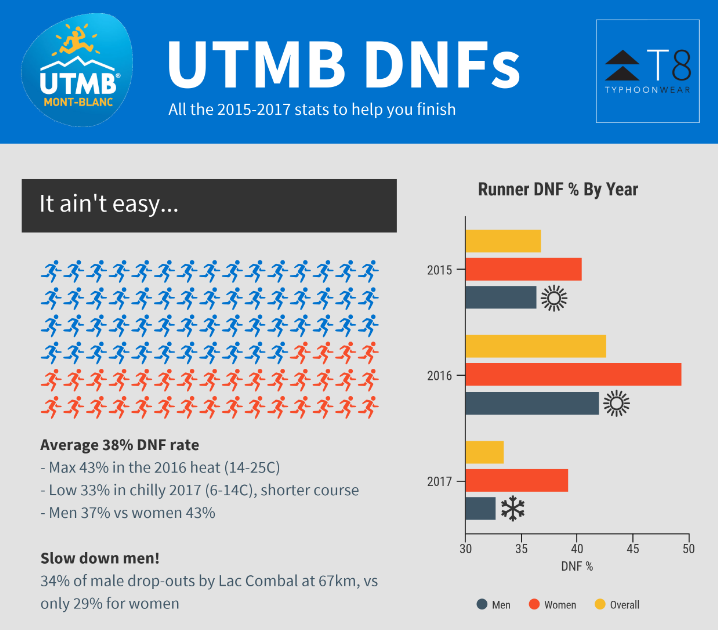在我們的UTMB 系列的第二部分中,我們詳細分析了2015 年至2017 年的DNF 統計數據,並重點介紹了關鍵要點、掉線和錯過關卡的危險CP,以及一些有用的專家提示,為自己提供最佳機會完成 UTMB 2018,並且強勢完成!

(滾動到最後,查看我們專家提供的一些很棒的專業提示)
關鍵統計數據
2015年至2017年,DNF平均發生率高達38%。海拔 171 公里,海拔 10,000 公尺 D+,可不是星期日的散步!不過,存在一些很大的差異,2017 年寒冷天氣(6-14C)和受雪影響的較短路線中,DNF 率僅為33%,而2015 年,溫度為14-25C 時,DNF 率飆升至43%。
男性完成比賽的機會更大,平均 DNF 率為 37%,而女性為 43%。然而,男子往往會更早退賽,其中 34% 的退賽發生在 Lac Combal 67 公里處。對於女性來說,當時只有 29% 的人退出了。
危險檢查點
依序來說,這些檢查點在所有 DNF 中所佔的比例最高:
- 庫馬約爾 17.7% - 重大里程碑且易於運輸
- Arnouvaz 15.4% - 2017 年因天氣寒冷而特別高
- La Fouly 13.9% - 雙腿現在開始變得非常累...
- 污染 10.5%——事情開始變得糟糕後的第一個主要 CP
- Lac Combal 8.9% - 在經歷了艱難的第一晚之後於清晨/中午抵達
不出所料,山區檢查站 DNF 僅佔總數的 8%,儘管佔所有檢查站的 40%。當您溫暖舒適的床不遠的時候,拉出來太容易了!
擔心停產?
與大多數比賽一樣,隨著比賽的進展,保持領先所需的速度會減慢。前往 St Gervais 和 Les Contamines 的早期路段需要超過 5kph,並且根據爬坡調整後接近 8kph(100m D+ = 1km,與 ITRA 換算一致)。在後期階段,速度會減慢至 3 公里/小時(或調整後的 5 公里/小時),但這對疲憊的雙腿來說同樣困難。
如果您的速度較慢,並且在衝彎時要特別注意進入阿努瓦茲 (Arnouvaz) 和科巴爾湖 (Lac Combal) 的路段。第一個60公里後,這些賽段調整後的最高速度為5.9公里/小時和6.2公里/小時,且截止選手數也最多。
快到家了!
關鍵是到達 - 和離開! - Champex Lac 檢查站位於 134 公里處。也許是因為距離「只剩下」47 公里了,但從這裡繼續前進,因為您知道現在有 94% 的機會完成比賽。
50 歲以上的跑者通常具有更高的 DNF 率,但令人驚訝的是,一旦他們離開 Champex Lac,到達霞慕尼的可能性更大。
避免可怕的 DNF 的專業提示
我們採訪了幾位精英跑步運動員,聽聽他們關於保持堅強並在良好的時間和狀態下到達終點線的明智建議。

澳洲的Majell Backhausen是夏蒙尼職業選手,他的成績證明了這一點- 2015 年第22 次UTMB(Ultra Trail 我的生日!)和2016 年第6 次TDS。一種令人難以置信的感覺,但你只能感受到最高的感覺當你經歷過最黑暗的地方並度過最艱難的時刻後,你必須表現出高度的情緒,如果你受傷了並且會遭受永久性的傷害,那就不要堅持下去,但如果你只是這樣。不要逃避。
英國選手艾米麗·伍德蘭 (Emily Woodland)在2017 年以32 分28 秒的成績排名第26 位,她建議:「你必須在不催促CP 之間取得適當的平衡,因為你必須花時間確保自己得到適當的補充,但又不能過度也很舒服,而且你需要一個知道什麼時候給你踢屁股的優秀團隊! ”
來自紐西蘭的Marie McNaughton經常在 Ultra Trail 世界巡迴賽賽事中進入前十名,甚至在 2016 年巡迴賽中獲得第十名。她堅信我們總是可以給予更多 - 「不要聽那些聲音。即使你非常確定你需要停下來,你也可以走得更遠。我們總是可以多走幾公里,所以讓自己通常情況下,事情會發生逆轉,當你認為自己已經完成時,你可能只完成了40%。
T8 的John Ellis從未參加過 DNF 比賽,並將其歸因於多種因素。 「你需要努力訓練,做好充分準備,當你到達起跑線時,比賽已經結束了 80%。記住,最多只有三到四個關鍵時刻你需要堅強起來。」離開那個溫暖的CP,休息一下,但堅持走下去會讓你感覺良好一個小時,但完成是你可以永遠保持的事情。
 來到新加坡,來自紅點跑步公司的前所羅門跑步者Jeri Chua是第一批完成 UTMB 的亞洲跑步者之一(還有 TDG,這個瘋狂的瘋子!)。她的建議是,「使用視覺輔助工具來阻止DNF 惡魔,並在容易理解的地方寫下你的理由- '這就是你報名的目的','痛苦是法式麵包,接受它,毛茛'或'你贏了'不要在終點線後悔」。你的孩子、配偶或貓的照片也可能有幫助——「為蒂布爾斯做這件事!」並保留一份DNF 清單:我會流血嗎?如果我繼續的話,我會死嗎? 如果您能回答 3 題中的 2 題,那麼您可能在休息 5-10 分鐘後就可以出發了。
來到新加坡,來自紅點跑步公司的前所羅門跑步者Jeri Chua是第一批完成 UTMB 的亞洲跑步者之一(還有 TDG,這個瘋狂的瘋子!)。她的建議是,「使用視覺輔助工具來阻止DNF 惡魔,並在容易理解的地方寫下你的理由- '這就是你報名的目的','痛苦是法式麵包,接受它,毛茛'或'你贏了'不要在終點線後悔」。你的孩子、配偶或貓的照片也可能有幫助——「為蒂布爾斯做這件事!」並保留一份DNF 清單:我會流血嗎?如果我繼續的話,我會死嗎? 如果您能回答 3 題中的 2 題,那麼您可能在休息 5-10 分鐘後就可以出發了。
」

